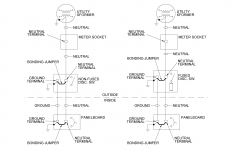I have a question that every time I think I know the answer, I read or watch a video that makes me doubt myself.
On a service, residential or industrial, the conductors that pass through the meter now need to enter a "disconnect" outside of the home or building.
My question is, the bounding jumper that bounds the neutral to ground, does this happen in the disconnect outside of the home and thus the neutral and ground will need to be separated from that point on or do you also tie the neutral and ground together say in a lighting panel that this disconnect is feeding, that before this new code came down, was your service disconnect and where the bonding jumper bonded the neutral to ground?
Another question, does this "disconnect" need to have over current protection, or can it just be non-fused?
If true, do you even bond the neutral in the disconnect or do you keep them separate until you land on the first over current protected device?
If you can point me to the NEC for the answer it would be much appreciated.
Thank you.
On a service, residential or industrial, the conductors that pass through the meter now need to enter a "disconnect" outside of the home or building.
My question is, the bounding jumper that bounds the neutral to ground, does this happen in the disconnect outside of the home and thus the neutral and ground will need to be separated from that point on or do you also tie the neutral and ground together say in a lighting panel that this disconnect is feeding, that before this new code came down, was your service disconnect and where the bonding jumper bonded the neutral to ground?
Another question, does this "disconnect" need to have over current protection, or can it just be non-fused?
If true, do you even bond the neutral in the disconnect or do you keep them separate until you land on the first over current protected device?
If you can point me to the NEC for the answer it would be much appreciated.
Thank you.

